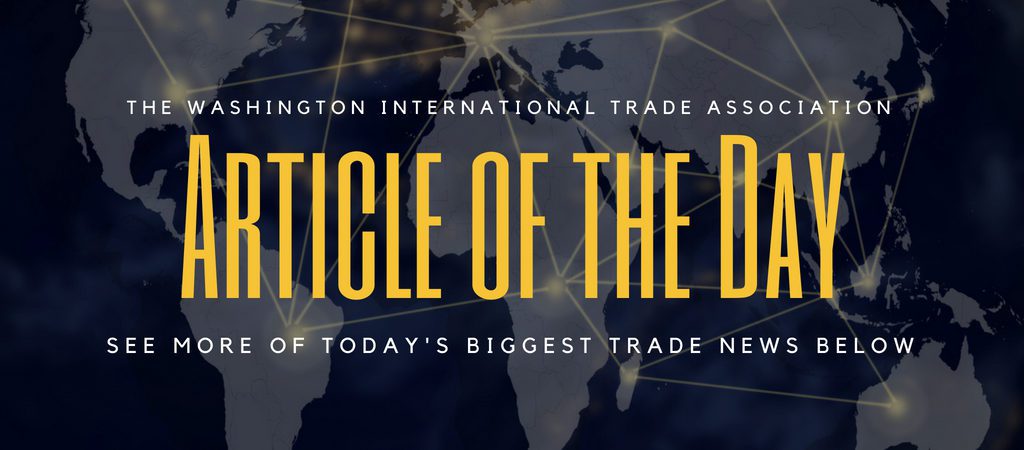The economic remedies for alleviating the public health impacts of COVID-19 on a country’s growth prospects stem as much from curative actions taken within the nation’s domestic domain as from initiatives directed at shaping the country’s international trade and investment posture.
Indeed, benefits engendered from salutary “behind-the-border” policies that foster greater market access to medical supplies, equipment and pharmaceuticals may well be undone by measures imposed “at the border” that restrict the market for exports or imports of such items.
Regrettably, an increasing number of governments—of advanced countries and emerging markets alike—have begun to embark on such a course. It is most perverse that in the midst of the worst global public health crisis in modern times, nations’ leaders are instituting trade-restricting regimes that are driving up prices, creating artificial scarcity, and lowering the quality of health care products and services available to their populations.
It is bad enough that the mitigation strategy implemented to curb the incidence COVID—“social distancing”—has shut down swaths of economies around the world as populations isolate themselves in their homes. That this will result not only in a global recession and reduction of incomes because of sharp falloffs of both demand and supply, but also a decline in global trade flows across virtually every sector imaginable, including in the health sector, is not in doubt.
The World Trade Organization’s (WTO’s) “Trade Barometers” for the first quarter of 2020 already reveal a secular weakening of world trade for both merchandise and services in the aggregate, with further declines in subsequent quarters a foregone conclusion.
But with trade restrictive policies being imposed in the health sector itself as the COVID crisis worsens, we are guaranteed to suffer at the hands of self-defeating trade policies in the one area where increased trade flows are needed most.
This is especially problematic because worldwide production of the most critical medical supplies needed for COVID is concentrated among relatively few suppliers. In other words, competitive market forces are already structurally restrictive.
Guess who has been leading the pack in this role? The U.S.— long the global champion for liberalizing trade. As part of Washington’s year-plus trade war with Beijing, the Trump administration has imposed almost $5 billion of tariffs on medical supplies the U.S. imports from China.
Worse still, the White House is also seeking to restrict trade and raise the costs of pharmaceuticals and medical equipment purchased by federal agencies by toughening the “Buy America Act,” the statute that cedes market power, and thus the ability to raise prices, to U.S. suppliers vis a vis foreign vendors who actually charge less.
Moreover, Washington has restricted the amount of visas permitted for the immigration of nurses to the U.S. from the Philippines; the number of such visas issued in 2015 was almost one-third greater than last year.
Self-inflicted wounds, however, almost always induce a change of heart. In fact, Trump now finds himself in a position of having to procure for U.S. healthcare workers increasingly exposed to COVID from the patients for whom they care, a significant amount of medical equipment no longer available either from U.S. private suppliers or Federal stockpiles.
Thus it was that on March 29, the first of 20 U.S. commercial carrier flights to take place in the coming weeks from Asia, flew into the West Coast from Shanghai carrying a significant shipment of medical masks, gloves, gowns and thermometers. The supplies were purchased by several U.S. companies and shipped on a flight paid for by FEMA.
The European Union’s recent actions, however, may well help to make the U.S. seem like a haven for free-trade in medical supplies.
In mid-March, Brussels issued a wide-ranging directive that implements a regime requiring member states to seek authorization for the export of masks, protective spectacles and visors, face shields, mouth-nose protection and protective garments. EU Commissioner for Trade Phil Hogan justified the move by indicating: “No effort is being spared by the Commission to offer concrete help to our citizens and all those who take care of them.”
Responding to immediate criticism from G20 Trade Ministers, Hogan dismissed the complaints, arguing his measures were simply meant to monitor EU exports of medical goods, not to restrict them. If that were so, he could have simply put in place an automated mechanism that collects the data he asserts are of such interest to him.
And beyond the EU-wide actions, France and Germany have instituted their own country-level measures that act as restraints on cross-border transactions of medical supplies and equipment.
For emerging markets, the initial conditions of the overall policy regimes governing international trade in medical supplies are not as favorable as they are in advanced countries. The most recent data show that the average import tariff rate in these product categories for least developed countries is just below 12% and for developing countries is almost 9%. In contrast, among advanced countries, the average import tariff rate is below 4%.
This is particularly pernicious as they could well turn out to be the countries hit hardest by COVID in terms of the direct impacts on the well-being of their populations due to nascent health infrastructures and more indirectly as deeply constrained disposable incomes can be stretched only so far to purchase available medical supplies.

